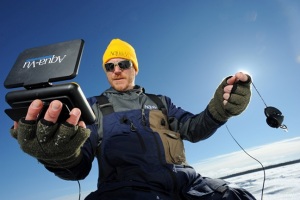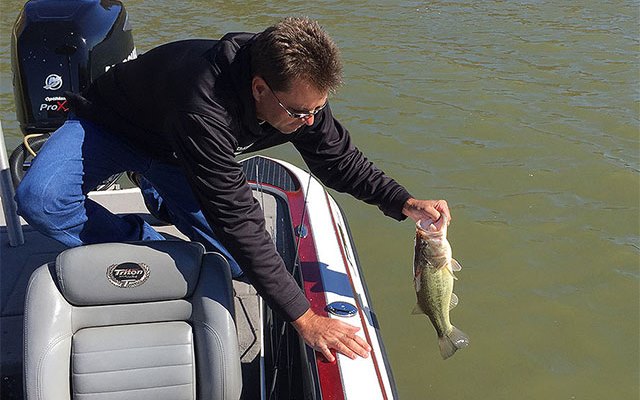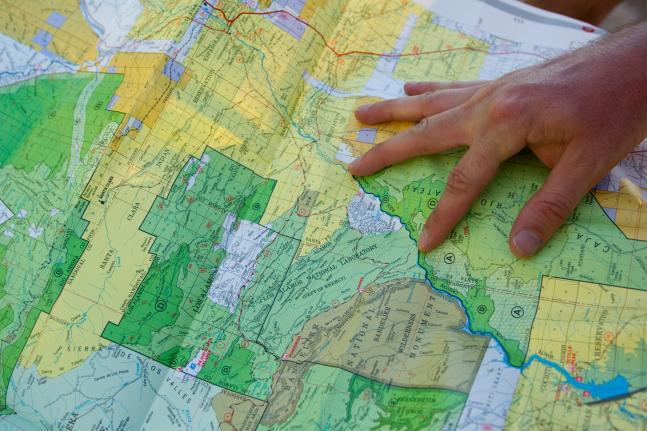Hatching Fish Improves Angling Success
After enjoying the thrill of reeling in a big bass, did you ever stop to think about where it came from? Your particular bass may be one of the many fish the Kentucky Department of Fish and Wildlife Resources (KDFWR) stocks in Kentucky waters each year. The department stocks over four million fish annually and about one million of them come from the Frankfort Fish Hatchery.
The Frankfort hatchery, one of two hatcheries the department operates, is located on Indian Gap Road off US 127 north of Frankfort and was formerly known as the Frankfort National Fish Hatchery. Built in the 1950s by the U.S. Fish and Wildlife Service on land owned by the KDFWR, this hatchery was one of several federal hatcheries which served our country's fishery resources. In October, 1986 the KDFWR assumed the responsibility of managing the Frankfort hatchery. The hatchery has 46 ponds with a combined total of 41.5 surface acres, and the water for its operation comes from Elkhorn Creek, a tributary of the Kentucky River.
The hatchery's main objective is to produce fish to improve fishing opportunities in Kentucky. Primarily a facility for warm-water species such as largemouth bass, channel catfish, bluegill and redear sunfish, the hatchery also produces species that prefer cool water such as walleye and striped bass. These two species are produced at the hatchery during months when water temperatures dip to extended lows. Goldfish are also reared for use as forage.
Before moving small fish into larger water areas at the hatchery, rearing ponds are filled and treated with fertilizers. These organic and/or inorganic additives ensure the availability of plankton (microscopic plants and animals) which the fry (newly hatched fish) eat. Organic fertilizers consist of hay, alfalfa meal and soybean meal while inorganic fertilizer contains nitrogen, phosphorous and potash. As the fish grow, food is provided by continued pond fertilization or by adding small goldfish or a commercially prepared food.
Pond management also includes the application of chemicals for algae or disease control, monitoring dissolved oxygen levels, feeding the fish and collecting them for transport and release. The ponds all have sloped bottoms to permit thorough draining. Collection is done by slowly draining the water and netting the fish. Then they're taken to the holding house for grading according to size, weighing and inventory. Finally, they're loaded onto special trucks for distribution statewide.
Recent hatchery renovations improved the water supply system and added a new hatching house complete with lab and computer warning system. If a problem develops in the hatching building, such as a change in water temperature, the computer is set to call, in sequence, the hatchery manager, hatchery biologist and various fishery personnel on down the line until someone responds. Besides the new hatching house, the hatchery also has rearing and brood ponds, an office building, feed house, storage building, garage and three residences for staff.
The overall cost for upgrading the hatchery amounted to $2.5 million, but included in that outlay is the possibility to save on expenditures in the future. One example is the hatchery's ability to produce hybrid stripers, hopefully in significantly large enough numbers so that the KDFWR no longer needs to purchase these fish from outside sources stocking purposes. In a nutshell, the hope is for the Frankfort to become self-sufficient. Hatchery improvements will also help increase the production of eight-inch channel catfish as well as shellcrackers and larger fingerling size largemouth bass, all with few manpower changes.
Visitors are welcome to view the ponds and display pool weekdays (M-F) between 7 a.m. and 3 p.m. The display pool is filled with numerous species of fish during the warmer months. Tours may be arranged for groups, clubs or classes by contacting hatchery personnel at (502) 564-4957. Additionally, the grounds contain a non-boating fishing access to Elkhorn Creek.
The other hatchery operated by the department is located eight miles southwest of Morehead. Minor Clark Fish Hatchery, one of the largest state-owned, warm-water hatcheries in the U.S., was named for Kentucky's first fishery biologist and former department commissioner.
Up and running in 1972 at an estimated cost of $2 million, the Clark hatchery covers 300 acres and has 111 rearing and brood ponds. It also has concrete raceways for holding fish, a display pool and three residences for employees. The main building houses an office, lab, feed preparation room, conference room and a large enclosure used to hatch eggs and hold fish. The hatchery's water supply comes from Cave Run Lake by gravity flow through an 18 pipe and as many as 8,000 gallons of water per minute can be taken from the lake.
Largemouth bass, smallmouth bass, walleye, striped bass (rockfish), hybrid striped bass and muskellunge (muskie) are produced here alone with large numbers of goldfish and minnows which provide food for the sport fish species. In the past, sauger, tiger muskie, Kentucky (spotted) bass, black crappie and redbreast sunfish were also produced.
Some adult species are maintained year round in hatchery ponds while other species that don't readily spawn are captured in early spring from selected state reservoirs and brought to the hatchery for human assisted spawning. Eggs are expelled from a ripe female by applying pressure on the abdomen. Milt from the male is deposited over the eggs by the same method. Eggs are stirred to insure fertilization, then rinsed with water and placed in plastic jars for incubation. Water temperature determines the hatching time which usually occurs in one to two weeks. The fry get their nourishment from yolk sacs for a time, then they begin feeding microscopic animals (zooplankton). Certain species may be fed commercially prepared food.
This hatchery is also open weekdays from 7 a.m. to 3 p.m. and free to the public. Guided tours may be scheduled by calling the Clark hatchery at (606) 784-6872.
Annually, millions of hatchery fish are released statewide in various Kentucky waters ranging from state lakes and rivers to small streams and farm ponds. (Farm ponds receive bluegill, channel catfish and largemouth bass through a program offered by the KDFWR.) So, the next time you're relaxing after a day of fishing in the commonwealth, think about the hard work that goes into maintaining that fishery resource. And thank the sportsmen of Kentucky who pay for it.
Reflections of a Farm Pond
Moon Phases


